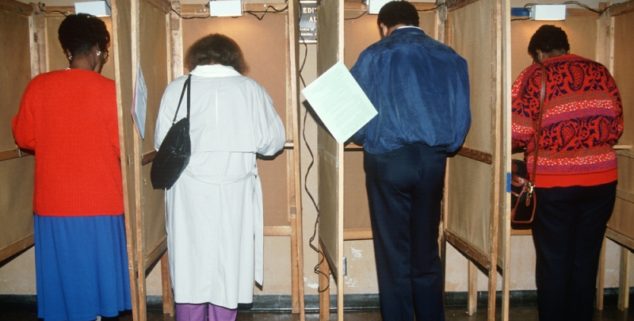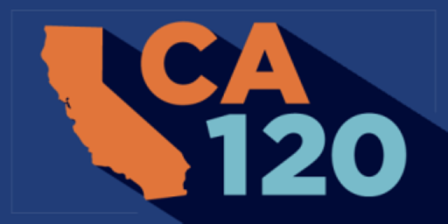News
CA120: California’s Voters Choice Act and the 2020 elections
 Voters in their booths casting ballots in a Los Angeles election. (Photo: Joseph Sohm, via Shutterstock)
Voters in their booths casting ballots in a Los Angeles election. (Photo: Joseph Sohm, via Shutterstock)One constant in California elections is change.
In the past 20 years, we’ve seen changes to when the primary is held, then changed back, then back again. We’ve seen an open primary, then another version of the open primary. We shook up the Legislature with term limits, then imposed different term limits. We have moved increasingly to vote by mail, shifting the timeline of our elections, and now there is a move in some counties to vote completely by mail.
In March of 2020 we will see 15 counties shifting to all-mail elections under the new Voters Choice Act model — 4.7 million voters in just those counties.
This shift will push the total number of voters being mailed ballots in 2020 to a record 15 million. This is a whopping 50% increase since California’s 2016 primary election.
Of those voters in the Voters Choice Act counties who are being mailed a 2020 election ballot, 28% did not elect to receive their ballots by mail when registering to vote and 35% have never mailed in an absentee ballot. This will pose some challenges, as county registrars and campaigns have to educate and turn out voters through a new mechanism.
In addition to all these new by-mail voters, Los Angeles County is doing a modified version of the VCA by using voting centers instead of neighborhood-by-neighborhood precincts, but not doing the mailing to all voters until 2024.
This means millions of Angelinos who aren’t voting by mail are going to find their local polling location was consolidated into a larger vote center. The only exceptions will be in about 15% of L.A. County, where the congressional and legislative districts overlap Orange County, which is doing all vote-by-mail. Those voters will all get ballots in the mail.
Some of the findings from the CCEP study could be important to campaigns that are trying to manage the impacts of the new system.
With this shift, we are looking at an election cycle that will present significant structural challenges to voters who, understandably, are used to doing things a certain way and could be confused by the changes.
This is not to say that these changes will necessarily have a net-negative impact.
A study recently produced by the California Civic Engagement Project with the help of Political Data’s archives provides in painstaking detail the ways in which different voters utilized the system. Other studies have shown some small positive impact on turnout in counties that piloted the vote center model in 2018.
Some of the findings from the CCEP study could be important to campaigns that are trying to manage the impacts of the new system.
There are real lessons to be learned in regard to which voters are most likely to vote by mail or at the centers and, for those who vote in the centers, if they will likely be casting those ballots in the first days or waiting until the very end.
If you’re working on a campaign that is within one of these newly transitioned VCA counties, here are some of the things to look for based on our experience with the system in 2018.
–Campaigns need to identify vote centers as soon as they are selected in each county, including breakdowns of when they are going to be opening up (some are 29 days out, some 11 days out, others only a few days).
–If you’re doing outreach, you might want to link each of the vote centers to the precincts that best align to each of the new location. (Yes, precincts still exist under the VCA, even though the direct relationship to a polling location has been stripped away.)
–If your campaign isn’t interested in walking or doing literature drops at the traditional precinct level, there are mapping methods that can be used to create custom carved areas that act like precincts for your campaign.
One of the main Election Day activities was taking those lists of supporters, by precinct, and marking them all off as they go to the polls and vote
–Watch for data on ballots as they are cast at each vote center, and if possible, learn from the data as it comes in how many voters are casting ballots at their most local center, or which might be voting at a center near work or school, further from their home precinct. There is some data on this from a few counties that used VCA in the 2018 cycle and building this data in the primary of 2020 will help target in the general election.
–Most importantly, make sure you’re tracking of by-mail ballot returns. We will be again doing the publicly available visualization of those returns for analytical purposes, but what’s more important is flagging voters on a daily basis to remove them from your targeted voter lists after they have cast a ballot.
And there’s one last almost magical tool for campaigns on Election Day.
In campaigns past, one of the main Election Day activities was taking those lists of supporters, by precinct, and marking them all off as they go to the polls and vote. (I’ve personally spent hundreds of hours on campaigns doing this).
The Vote Center model is the brave new world of our elections in California.
Well, things have changed.
Vote centers aren’t posting lists at the door of who has voted, leaving most campaigns blind as to how their Election Day turnout is faring.
But in some counties, like L.A., they will be posting hourly updates on exactly who has shown up at the polls. With this data coming in throughout the day, your campaign can create a list of supporters, removing anyone who voted and literally re-running that list every hour.
These updated lists of supporters who haven’t returned a ballot are at your fingertips without having to send any volunteers out into the field to collect them.
The Vote Center model is the brave new world of our elections in California, and winning campaigns and consultants will be those who adjust their methods to meet the challenge.
I have been fortunate enough to be there, in the discussions with state leadership as the VCA was being created, testifying in the Legislature on the legislation as it was being considered, working with counties as it was piloted, helping researchers as it is analyzed, and working with campaigns to make sure that they are making the most out of it in the field.
Now its up to the campaigns to make small adjustments to how they run their efforts in order to in the new system.
—
Editor’s Note: Paul Mitchell, a regular contributor to Capitol Weekly, is the creator of the CA120 column, vice president of Political Data Inc., and owner of Redistricting Partners, a political strategy firm.
Want to see more stories like this? Sign up for The Roundup, the free daily newsletter about California politics from the editors of Capitol Weekly. Stay up to date on the news you need to know.
Sign up below, then look for a confirmation email in your inbox.

Leave a Reply